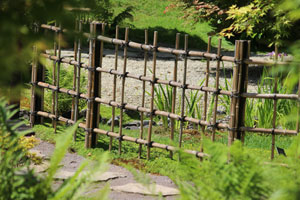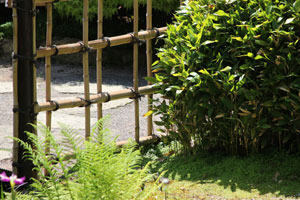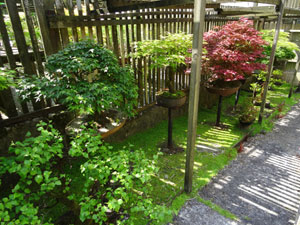Bamboo Fences and Fencing Screens
Japanese Garden Design

One of the simplest ways to define sections within a Japanese garden is the addition of a bamboo fence (Sodi-gaki), which forms an immediate boundary and can be used to hide certain areas whilst also providing a backdrop for a statue or Zen garden rocks.
Types and Styles
There are several different types of bamboo fencing, gates (shiorido) and screens that you can purchase from specialist suppliers. Some fencing panels have small windows in the centre, allowing you to see other areas of the garden without hiding them completely.

Geisha screens resemble a lattice-style bamboo trellis, while a Zen Hashida screen features a central trellis section, from top to bottom, and Tanishi screens have a trellis section at the very top.
Low fencing screens are known as 'Saki De', while solid 'Nori' screens come with a strong bamboo frame where the structure is usually strengthened with the addition of some relatively stiff wire.
Weather Protection

Whatever bamboo fence you decide upon, it should be noted that it will benefit from an annual coat of clear varnish, which will prolong its life by many years and prevent it from rotting during a wet winter.
It may still be necessary to re-tie some of the joins of an open 'Kinkakuji Gaki' fence with black twine or similar palm fibre, which will be unlikely to last more than a few years.
Making Your Own Homemade Versions

Smaller fences can be made yourself by simply using smooth wooden posts as the main supports to a wooden frame. By building a simple framework around the posts, you can then tack a roll of split bamboo or rattan screening along the top, thereby creating a very affordable fence for a fraction of the price.
Another cheap alternative is to just buy some pale, diagonal timber trellis and cover the top and sides with some split bamboo, to give the illusion of a traditional natural screen.
 One of the simplest ways to define sections within a Japanese garden is the addition of a bamboo fence (Sodi-gaki), which forms an immediate boundary and can be used to hide certain areas whilst also providing a backdrop for a statue or Zen garden rocks.
One of the simplest ways to define sections within a Japanese garden is the addition of a bamboo fence (Sodi-gaki), which forms an immediate boundary and can be used to hide certain areas whilst also providing a backdrop for a statue or Zen garden rocks. Geisha screens resemble a lattice-style bamboo trellis, while a Zen Hashida screen features a central trellis section, from top to bottom, and Tanishi screens have a trellis section at the very top.
Geisha screens resemble a lattice-style bamboo trellis, while a Zen Hashida screen features a central trellis section, from top to bottom, and Tanishi screens have a trellis section at the very top. Whatever bamboo fence you decide upon, it should be noted that it will benefit from an annual coat of clear varnish, which will prolong its life by many years and prevent it from rotting during a wet winter.
Whatever bamboo fence you decide upon, it should be noted that it will benefit from an annual coat of clear varnish, which will prolong its life by many years and prevent it from rotting during a wet winter. Smaller fences can be made yourself by simply using smooth wooden posts as the main supports to a wooden frame. By building a simple framework around the posts, you can then tack a roll of split bamboo or rattan screening along the top, thereby creating a very affordable fence for a fraction of the price.
Smaller fences can be made yourself by simply using smooth wooden posts as the main supports to a wooden frame. By building a simple framework around the posts, you can then tack a roll of split bamboo or rattan screening along the top, thereby creating a very affordable fence for a fraction of the price.